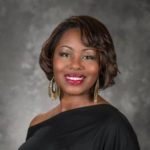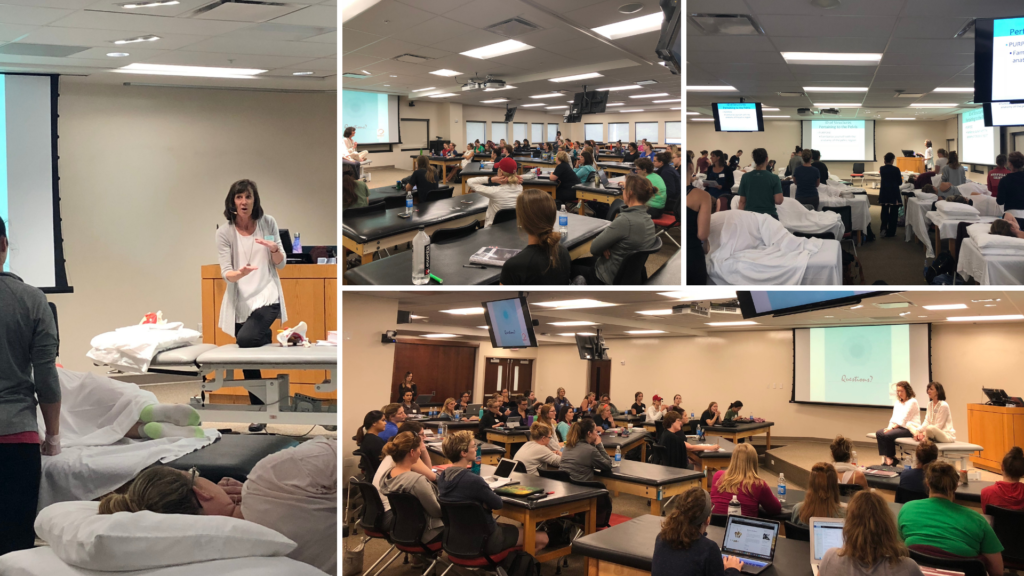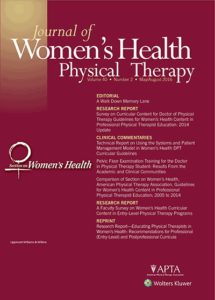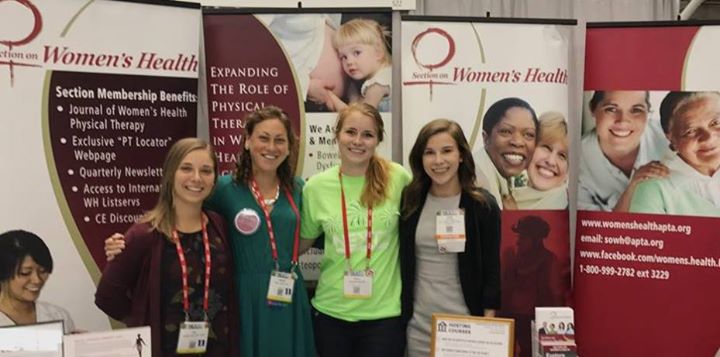When Your Superpower is Member Development and Revenue Generation: Tamela Blalock, CAE, CMP, DES

If you could have a professional superpower, what would it be? Tamela Blalock, MBA, CAE, CMP, DES considers her professional superpower to be revenue generation, but after talking with her about her experiences as an association leader, our staff at the Adviser thinks developing authentic empathy that nurtures others’ professional growth should be considered one of her superpowers, too.
Tamela is the executive director of the Section on Women’s Health (SoWH), a membership and educational organization of physical therapists whose mission is to advance global excellence in abdominal and pelvic health through education, research and social responsibility. The SoWH is a special interest affiliate of the American Physical Therapy Association that strives to expand the role of physical therapy in women’s (men’s and gender non-conforming people’s) health across their lifespan.
We talked with Tamela about how she applies a sales mindset to membership growth, revenue generation and board development. She explains why teaching high schoolers was the most terrifying but also the most refining thing she’s done in her professional life, and why experienced professionals should mentor someone who looks nothing like them. Serving a mission-driven association is the career path “I never knew I always wanted to do,” she says, because it’s the best combination of revenue generation with purpose.
Association Adviser: You’ve had jobs across a spectrum of organizations: the Central Intelligence Agency, the Washington NFL Professional Team, a high school, a convention and visitors bureau and association management companies. How did these jobs prepare you for your current position with SoWH?
Tamela Blalock, MBA, CAE, CMP, DES: While my job as an operations research analyst at the CIA prepared me the most, all of these positions prepared me to be an association director in that in order to be successful in those positions, you need to be able to integrate yourself into a community and empathize with community members.
While at the CIA I worked with countries known for terrorism, but the most terrified I’ve ever been in my life was teaching high school. Outside of kindergarten, no one will disarm you of your false sense of confidence more than teenagers. I don’t know when we lose the BS meter, but it’s high when you’re a teenager! Their commitment isn’t necessarily to learn. It’s to show up and be awake. You as the teacher have to motivate them to learn, to cooperate, and to do more than just be there. If you want to learn how to genuinely connect with an audience, and practice public speaking, teach high schoolers. The responsibility to inspire will be on you.
But the CIA job probably prepared me the most for my current position because the job skills are similar. The goal at the CIA is to achieve a mission with a very specific audience and outcome. Which is what association executives do, although with associations the outcome is almost always happy and delightful. I appreciate that nuance of being an association executive!
AA: You worked at the National Association of Wholesaler-Distributors for four years, in which time you grew association membership by 18 percent. How did you do it?
TB: Sometimes in trade associations, even though membership is often a business to business connection, you forget that people are still the ones making decisions. Even though the business is the recognized member, there are human beings who sign the contract and send the check. At NAW, I worked at finding out what the individual behind the business needs for their career that isn’t being met elsewhere. How could NAW meet those needs through membership? What areas of weakness could we improve upon to stop member loss and rebuild our numbers? Your weaknesses are exposed when more and more members don’t renew. But that attrition can be attacked guerilla warfare-style: When you have fewer people to learn about, you have more time and resources to study them and find out what their needs are. NAW put a plan in place to meet those needs.
Our first step was to look at our attrition numbers and shore up that group. We offered benefits and a return on membership that satisfied them. Then we grew membership by asking them to refer potential members to us. Cold calling for membership wouldn’t work. Trade business executives hate cold calls. So we created an environment where current members wanted to refer people to us. We created a sense of FOMO among potential members by turning current members into ambassadors for NAW.
AA: Which departments were involved?
TB: Mostly membership and government relations. Education, part of our membership department, was also involved.
AA: What kinds of marketing efforts did you launch to support this drive?
TB: I changed NAW’s marketing from outbound to more inbound and relationship-based. We moved away from straight email blasting to creating appointment style communications (e.g. weekly newsletters). We created resources for members and potential members to measure interest in certain things and to give us an opportunity to ask them to perform more actions that would further inform NAW’s membership marketing plan. We also used gifts and thank-you notes to build loyalty and make members feel special. People underestimate the power of thank-you notes and gifts! Lots of associations, particularly trade associations, have books from speakers or other inventory sitting around somewhere. Clear out your inventory! Send it to members whether they were able to attend an event or not and make them feel like they are the only member (or your favorite member) in your association.
AA: You also have a strong track record in sales – campus housing sales, hotel rooms, memberships. What are the foundational strategies and tools you use to meet your sales goals?
TB: The same strategies that I used at NAW and the CIA. The CIA is where I learned that sales is motivating people to specific outcomes. In the case of associations, the outcome is a purpose, and association members are adopting a purpose by making a making a membership purpose. I’ve translated this approach to sales no matter where I’ve worked. At NAW and now SoWH, I tell members, “I’m going to take care of your professional needs. I’m going to give you access to something you want.” I think of membership development and revenue generation as my superpower, and calibrate that superpower to the mission of my organization.
AA: What are your main responsibilities as executive director of the Section on Women’s Health?
 TB: Overall, it’s to assure that the SoWH achieves its mission of advancing global excellence in abdominal and pelvic health, that it is faithful to its strategic plan, and that it meets, if not exceeds, its key performance indicators for the year.
TB: Overall, it’s to assure that the SoWH achieves its mission of advancing global excellence in abdominal and pelvic health, that it is faithful to its strategic plan, and that it meets, if not exceeds, its key performance indicators for the year.
Within a week, there are days that focus on key project management, days where I have meetings with internal and external stakeholders about team development and enhancement, and days that focus on finance. Every day, I’m making sure that the lines of communications between our headquarters team and our board of 12 stay open. I say team, not staff, because no one person is better or more important than another and our focuses are different but complementary.
AA: Tell us about working with the Section on Women’s Health board.
TB: One of the first major acts I did as executive director was work with board to update our bylaws. We increased the size of our board by two members in order to build a better succession plan for the president’s role. Before, the presidential role was one term of three years, and there was no real ramp-up or sun setting associated with the role. You were elected president and five months later you entered the role, which does not allow a lot of time for planning. There was no requirement to serve as president-elect and formally learn the role, or to serve as immediate past president and advise about the role. This was harming the consistency with which our strategic plan was implemented.
So we took the same three-year commitment and specified what the succession will be. In year one, you are the president-elect and learn the responsibilities of the president’s role. In the second year, you fulfill the president’s role. In year three, you are the immediate past president and advise the current president; be their resource and focus on developing other leaders coming into the funnel.
Having a three-year succession plan helps ensure that organizational goals will be successfully implemented. It also opens up the opportunity to a wider swath of members. When we ask someone to be president, we are asking for a huge amount of grace from their employer, their spouse, their partner, their families and their whole community because it is an intense job. Making the president’s role a gradual three-year experience with two people helping you versus an intense three-year job on your own diversifies the number of people who can experience board leadership.
I’m very fortunate that I had a president who was very much game for this change. She will serve as president for two years in order to train a president-elect, agreed to have a shorter term overall, and was the person who ushered in this change, which was a lot of work. I was also fortunate to have an immediate past president who agreed to fill that role for two years, and a board that is open and excited to enact this change. We voted on the change in June and just finished our first election under these new bylaws earlier in September. We’ve seen positive results so far. Before, people wanted to serve as president but were intimidated by the commitment. Now, more people (and people from more diverse professional backgrounds) are interested in serving.
AA: The Section on Women’s Health at APTA focuses on “providing high-quality continuing education through courses, publications and outreach.” Why is education the primary focus?
TB: Because we are a specialty, and to advocate for the specialty is to nurture the training development of people within it. So we are committed to ensuring that PTs get the best education, rise to the highest level of excellence, and encourage others to choose this specialty.

AA: How does your team ensure participants receive the most updated education possible?

TB: We have amazing Certificate of Achievement Program in Pelvic Health (CAPP) that our association developed to certify physical therapists (PTs) in the management of patients with pelvic health issues (such as incontinence or pelvic pain). CAPP committee members serve as the SoWH faculty that review and edit educational materials and the research that we publish in our course manuals and lab manuals. Our CAPP Faculty also serve as the instructors to the 50-plus live courses we deliver each year.
AA: How are SoWH’s educational materials and courses funded?
TB: Internally through reinvesting our revenues from dues and fees. We deliver eight in-person courses several times a year: our CAPP Pelvic (CAPP-Pelvic) and CAPP in Pregnancy/Postpartum Physical Therapy (CAPP-OB) courses, plus specialty topic courses like treating pre-menopausal or pediatric patients taught by partners from PT specialties. These courses are developed internally with our own funds. Most are face-to-face courses. Fees from the courses are one of our revenue generators, and we reinvest that revenue in our courses and education delivery.
AA: What are your goals for yourself and for the SoWH over the coming year?
TB: For the SoWH: To grow revenue and budget size, because that increases what we’re able to do. We want to grow courses that give more access to professionals, especially PT assistants, who are interested in learning more about pelvic health and physical therapy. We’re increasing access to PT education globally through partnerships that give us avenues to deliver our education to a broader audience outside the U.S. Expanding educational opportunities for PTs increases access to physical therapy treatment for all women (and men) so they can have more freedom of movement, graceful aging, and more fulfilled lives. It’s not the job of the patient community to understand the difference between our specialties and find the appropriate specialty care. It’s our job to help obstetricians, gynecologists, nurse practitioners, athletic trainers, medical and associated professionals help their patients understand their care options and help them decide which care they should pursue.
For that goal, I want to see strong partnerships for the SoWH and intentional community growth. We are a membership organization but I’m noticing that engagement with an association is coming from all levels of involvement in the PT community. I don’t want to turn anyone away because their engagement involves activities besides joining as a member. Let’s have that space open whether they are a member or another type of customer.

For myself, I want to see strong partnerships for this organization and have the largest revenue growth during any executive director’s tenure. The more margin we earn, the more mission we can achieve. I want to develop my team and coach them toward empowerment in their position and their solutions while providing the environment that’s needed for career growth. I want to keep the contract between our board and our members, and provide both groups with the ROI and professional development that they would not have access to otherwise in their medical career.
AA: Why should experienced professionals like you look for mentorship opportunities, and how can they start?
TB: I’m a firm believer in to whom much is given, much is expected. I don’t care who you are: We’re only able to be successful because we all receive help. Be wary of people with a heroic narrative of exerting only their own blood and sweat to achieve success. We’ve all received support and sponsorship, and we should honor that commitment through serving as mentors and sponsors.
Secondly, we should mentor because of how much you can learn back. There are things we still miss as experienced professionals. Mentoring keeps me up to date on newer trends and exposes me to different perspectives. If you don’t mentor, you lose an opportunity to learn how to be authentic with a larger audience and the chance to keep your ideas relevant to the time and space in which we’re operating. Mentoring helps you stay effective at your career and as a leader.
Mentor people who don’t remind you of yourself and don’t have the same background as you. Mentor people who don’t look like you! You’ll learn more about the realities of other people which will only strengthen you as an executive.
AA: What is your favorite part of working in the association community?
TB: That there’s purpose behind it. Making money for an organization is my superpower, but in the for-profit space that benefits mostly senior partners or shareholders. Earning money just for that narrow group of beneficiaries doesn’t give me a sense of success. The revenue you generate for a mission-driven organization has a real impact on more people’s lives – not just members but the people they teach and treat. What my team members do has a purpose beyond quarterly returns broadcast on CNBC or published in the Wall Street Journal. The association space is the best of both worlds. It’s what I never knew I always wanted to do.
AA: In terms of your job, what keeps you up at night?
TB: I don’t live in a state of fear. But what drives me is ensuring that what we do is relevant. If our leadership was in a state of complacency, then I would be awake at night. However, because our goal is to ensure we’re relevant, I’m more excited to get up in the morning. I don’t feel trepidation at night. I’m fortunate and blessed that I work with a team that works hard to stay relevant.

